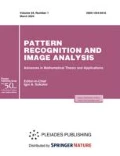Abstract
The article deals with the detection of document machine-readable zones (MRZ) in images obtained with the aid of small-size digital cameras. The herein proposed method is based on the mutual arrangement of binarized image connected components. A graph is plotted the nodes of which are the center of the black connected components. Distribution of the graph edges provides information on the document orientation whereby the algorithm is made rotation-invariant. Paths which satisfy special requirements and highly likely correspond to the MRZ lines are searched for in the graph. Such paths are clustered and then the most consistent cluster is selected with due regard for knowledge on possible MRZ geometrical characteristics. The square enclosing this cluster is the answer to the algorithm. Tests performed on open sets of data showed substantial improvement in detection quality as compared with the state-of-the-art methods. The computational complexity of the algorithm allows its real-time use in mobile devices.











Similar content being viewed by others
Notes
Data are available upon request.
REFERENCES
ICAO Doc 9303: Machine Readable Travel. Seventh Edition. Parts 2-7 (International Civil Aviation Organization, 2015).
K. B. Bulatov, D. A. Ilin, D. V. Polevoy, and Yu. S. Chernyshova, “Problems of machine-readable zone recognition captured with digital mobile cameras,” Trudy ISA RAN 65 (3), 85–93 (2015) [in Russian].
V. V. Arlasarov, A. E. Zhukovsky, V. E. Krivtsov, D. P. Nikolaev, and D. V. Polevoy, “Analysis of features of the use of fixed and mobile small-sized digital video camera for OCR,” Inf. Tekhnol. Vychisl. Sist., No. 3, 71–78 (2014) [in Russian].
Yu. S. Chernyshova, A. V. Sheshkus, and V. V. Arlazarov, “Two-step CNN framework for text line recognition in camera-captured tmages,” IEEE Access 8, 32587–32600 (2020).
Yu. V. Visilter, S. Yu. Zheltov, and A. A. Lukin, “Development of OCR system for portable passport and visa reader,” in Document Recognition and Retrieval VI, Proc. SPIE 3651, 194–199 (1999).
Y.-B. Kwon and J.-H. Kim, “Recognition based verification for the machine readable travel documents,” in 7th International Workshop on Graphics Recognition (GREC 2007) (Curitiba, Brazil, September 20–21, 2007), pp. 1–10.
K.-B. Kim and S. Kim, “A passport recognition and face verification using enhanced fuzzy ART based RBF network and PCA algorithm,” Neurocomput. 71 (16-18), 3202–3210 (2008).
F. Martín-Rodríguez, “Automatic optical reading of passport information,” in Proc. 2014 International Carnahan Conference on Security Technology (ICCST) (Rome, Italy, 2014), pp. 438–441.
A. Hartl, C. Arth, and D. Schmalstieg, “Real-time detection and recognition of machine-readable zones with mobile devices,” in Proc. 10th International Conference on Computer Vision Theory and Applications (VISAPP 2015) (Berlin, Germany, 2015), Vol. 3, pp. 79–87.
N. S. Skoryukina, “Machine-readable zones localization method robust to capture conditions,” Trudy ISA RAN 67 (4), 80–85 (2017) [in Russian].
A. S. Tlebaldinova, Ye. B. Kuandyk, and M. S. Asylbekova, “Detection of machine-readable zone of ID-documents online,” in Best Scientific Article 2018: Collection of Articles of the XIX International Scientific Research Competition, MTsNS “Nauka i Prosveshchenie,” Penza, 2018), pp. 12–16 [in Russian].
C. Cobârzan, M. A. Hudelist, K. Schoeffmann, M. J. Primus, “Mobile image analysis: Android vs. iOS,” in Multimedia Modeling, Proc. 21st International Conference, MMM 2015, Part II, Ed. by X. He, S. Luo, D. Tao, et al., Lecture Notes in Computer Science (Springer, Cham, 2015), Vol. 8936, pp. 99–110.
ACKNOWLEDGMENTS
This study was supported by the Russian Foundation for Basic Research (project nos. 17-29-03170, 17-29-03161).
The data generated and provided by the authors of [9] were used.
Author information
Authors and Affiliations
Corresponding authors
Ethics declarations
The authors declare that they have no conflict of interest.
Additional information

Sergey Igorevich Kolmakov. Born in 1995. Entered the Faculty of Innovation and High Technology, Applied Mathematics and Informatics, Moscow Institute of Physics and Technology in 2017. Scientific interests: image analysis, computer vision.

Natalya Sergeevna Skoryukina. Born in 1991. Programmer 1st category, Federal Research Center “Computer Science and Control,” Russian Academy of Sciences. Scientific interests: image analysis, computer vision.

Vladimir Viktorovich Arlazarov. Born in 1976. Head of Department No. 93 of the Federal Research Center “Computer Science and Control,” Russian Academy of Sciences. Scientific interests: artificial intelligence, machine learning, recognition systems, information technology.
Rights and permissions
About this article
Cite this article
Kolmakov, S.I., Skoryukina, N.S. & Arlazarov, V.V. Machine-Readable Zones Detection in Images Captured by Mobile Devices’ Cameras. Pattern Recognit. Image Anal. 30, 489–495 (2020). https://doi.org/10.1134/S105466182003013X
Received:
Revised:
Accepted:
Published:
Issue Date:
DOI: https://doi.org/10.1134/S105466182003013X




